Table of Contents
-
What Makes a Perfect Princess Bedtime Story
-
When Your Kid Needs Classic Comfort (Stories 1-5)
-
For Kids Who Ask “Why Are All Princesses White?” (Stories 6-10)
-
Perfect for Strong-Willed Kids (Stories 11-15)
-
When Your Child Needs Friend Drama Help (Stories 16-19)
-
For the Little Problem Solvers (Stories 20-22)
-
When Bedtime Gets Emotional (Stories 23-25)
-
How Each Story Meets Essential Selection Criteria
-
Creating Personalized Princess Adventures with AI
TL;DR
-
Princess bedtime stories aren’t just entertainment – they’re sneaky ways to teach your kid about courage, kindness, and problem-solving while actually getting them to sleep
-
The best princess stories hit that sweet spot between age-appropriate and educational, with diverse characters that don’t make you cringe
-
Classic fairy tales are still popular for a reason, but modern versions where princesses actually do stuff (instead of just waiting around) work way better
-
Stories from different cultures aren’t just politically correct – they’re genuinely more interesting and help kids see beyond their own little world
-
Modern independent princesses are perfect for kids who roll their eyes at traditional “rescue me” storylines
-
Friendship and problem-solving stories help kids work through their own social drama and challenges
-
The best bedtime princess stories have gentle pacing and happy endings that actually calm kids down instead of wiring them up
-
AI story generators can create custom princess adventures when your kid wants something super specific that doesn’t exist in any bookstore
If you’re reading this at 9 PM while your kid insists they need “just one more story” and you’ve already read Frozen for the millionth time, I feel you. We’ve all been there – desperately scrolling through the same tired princess books, wondering if there’s anything new that won’t leave your child wired for another hour.
According to Readmio’s research on children’s literature preferences, princess stories have remained “a staple in children’s literature for centuries, transcending cultures and generations” because kids naturally see themselves as the heroes in these magical tales. I discovered this firsthand when my niece insisted on wearing her plastic tiara to bed every night, declaring she needed to “practice being a real princess” in her dreams. That simple moment made me realize how deeply these stories connect with children’s sense of identity and possibility.
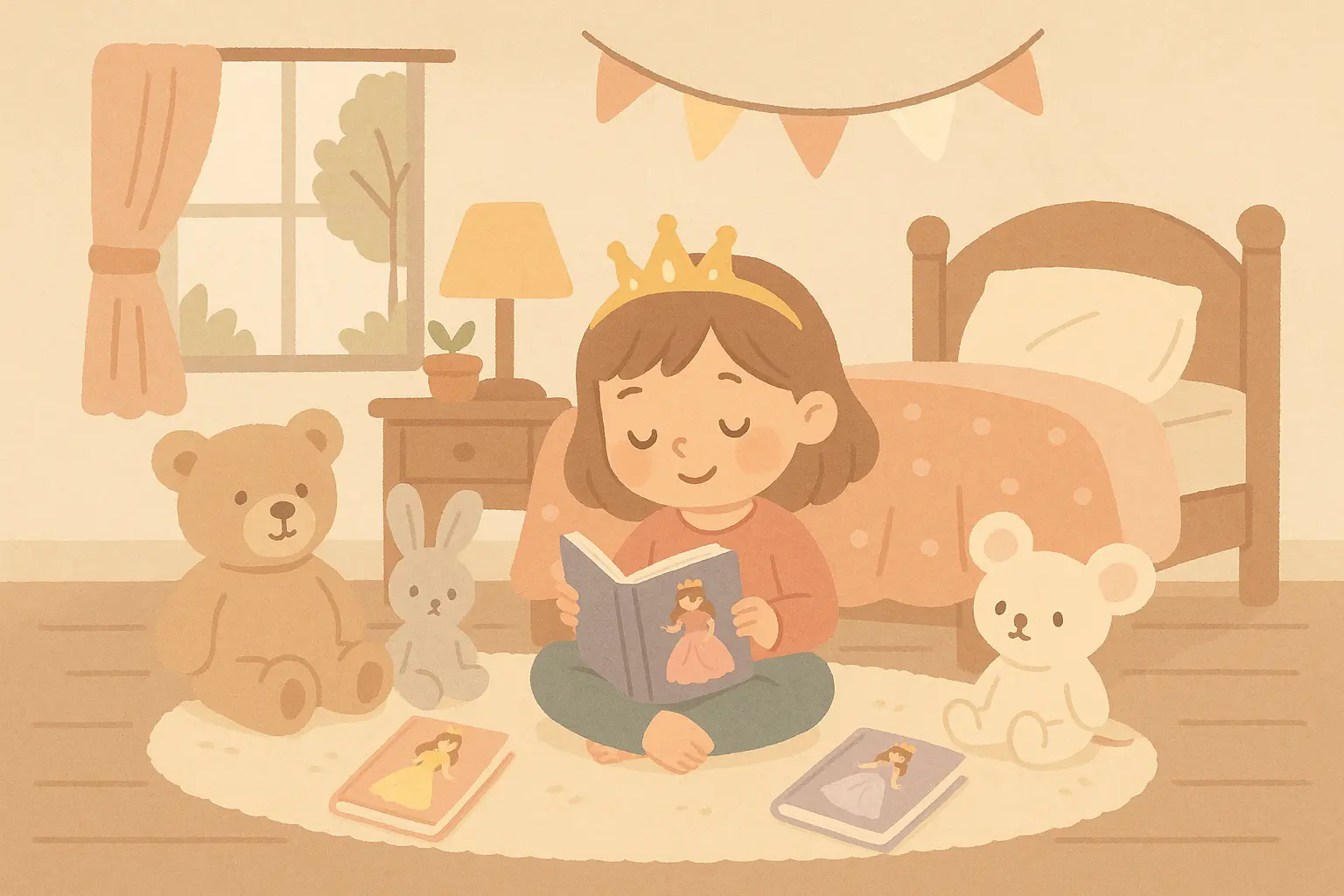
Here’s what I’ve learned after years of bedtime battles: princess stories do way more than entertain. They create this magical bridge between imagination and real-life lessons kids actually need. Whether you’re dealing with a child who fights bedtime or one who craves adventure before sleep, the right princess story can transform your nighttime routine from a struggle into the part of the day you both look forward to.
Parents seeking more options for their nighttime routines will find additional inspiration in our comprehensive guide to bedtime stories for kids that actually work, which complements princess-themed tales with other proven story types.
What Makes a Perfect Princess Bedtime Story
Look, choosing princess bedtime stories is trickier than just grabbing the first book with a crown on it. You need stories that will actually calm your kid down instead of getting them all worked up asking for “just one more chapter” at 10 PM.
|
Age Group |
What Actually Works |
How Long Before You’re Free |
What They’re Learning |
|---|---|---|---|
|
3-5 years |
Simple words, clear good guys vs bad guys, repetitive parts they can “help” with |
5-10 minutes (if you’re lucky) |
Being nice, sharing, basic feelings |
|
6-8 years |
More complex plots, characters who grow, mild conflict that gets resolved |
10-15 minutes |
Friendship drama, problem-solving, being brave |
|
9-12 years |
Sophisticated themes, cultural stuff, nuanced lessons |
15-20 minutes |
Independence, figuring out who they are, fairness |
Age appropriateness is huge here. A three-year-old needs simple vocabulary and super clear moral lessons, while an eight-year-old can handle more complex stories with character development. The story should challenge your child’s brain without overwhelming them or introducing concepts that might cause 2 AM anxiety attacks.
The cool thing about the best princess stories is your kid learns stuff without realizing it. They think they’re just hearing about Cinderella being nice to mean people, but they’re actually picking up lessons about kindness. Or they’re following Mulan’s military adventures while learning about courage and family loyalty. These lessons stick around long after the story ends, shaping how they see the world.
Let’s be real – if your kid only knows Disney princesses, they’re missing out on some amazing stories from around the world. Your story collection should reflect the actual diverse world your child lives in, with princesses from different backgrounds and circumstances. This isn’t just about being politically correct – these stories are genuinely more interesting and help kids see beyond their own little bubble.
Here’s the thing about bedtime stories: structure and pacing matter way more than you’d think. You want tales that build gentle excitement but resolve peacefully. Avoid cliffhangers or overly exciting climaxes that might energize your kid instead of calming them down. The story should naturally lead toward a satisfying, peaceful conclusion that promotes relaxation.
Visual appeal matters, but you don’t want illustrations that overstimulate before sleep. Look for artwork with calming colors and images that support the story rather than competing with it for attention. And honestly, contemporary relevance is key – princess stories that address modern themes your child can relate to (independence, emotional intelligence, personal agency, diverse family structures) while keeping the magical elements that make princess stories special in the first place.
When Your Kid Needs Classic Comfort (Stories 1-5)
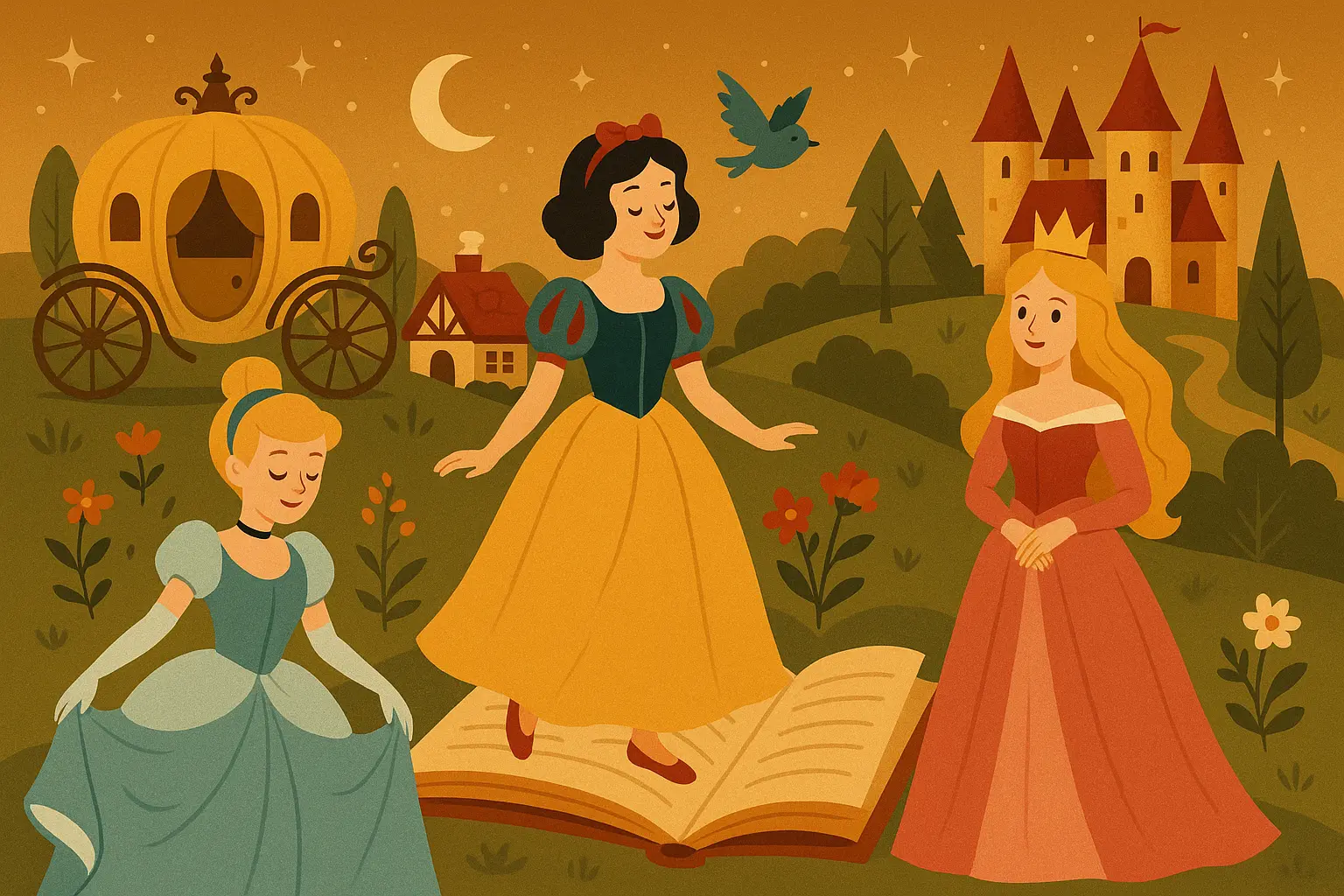
1. Cinderella
The ultimate story about a kind-hearted girl who deals with mean people through perseverance and inner beauty. Cinderella’s got magical transformation, a royal ball, and the satisfying triumph of goodness over cruelty – perfect for kids who need reassurance that being nice actually pays off.
This one’s perfect when your kid is dealing with mean kids at school. When I read Cinderella to 4-year-old Emma, her mom focused on how Cinderella helped her stepsisters get ready for the ball despite their meanness. “Even when people aren’t nice to us,” she explained, “we can still choose to be kind.” Emma started applying this lesson at preschool, showing kindness to a classmate who had been excluding her from games. The story became their go-to for discussing how to respond to unkind behavior with grace.
Fair warning though – younger kids might get scared of the stepsisters, so you might need to tone down the “mean” parts. There are tons of different versions, from the Brothers Grimm to Disney, so you can pick what works for your kid’s age and sensitivity level. Modern retellings often show Cinderella actually doing stuff to improve her situation rather than just waiting around for rescue, which teaches kids they have power to change their circumstances.
The story naturally builds toward the peaceful royal wedding conclusion, making it ideal for bedtime. The magical elements – fairy godmother, pumpkin carriage, glass slippers – capture imagination without being scary, while the clear lesson about inner beauty works across all age groups.
2. Sleeping Beauty (Briar Rose)
A princess cursed to sleep for a hundred years until awakened by true love’s kiss. Sleeping Beauty literally focuses on sleep, making it structurally perfect for bedtime stories. The tale explores patience, hope, and love’s power to overcome impossible obstacles.
The story’s pacing naturally slows toward the peaceful conclusion, with the princess’s long sleep serving as a calming image for kids preparing for their own rest. Real talk though: consider whether the century-long sleep might worry anxious children who fear not waking up. I tried this with my anxious 4-year-old thinking the sleep theme would be perfect. Big mistake. She spent the next week worried she wouldn’t wake up. Know your kid.
The spinning wheel curse teaches about consequences and protection, while the three good fairies show how community support helps overcome challenges. You can adapt it to focus more on the fairies’ protective magic and less on the darker curse elements.
3. Snow White and the Seven Dwarfs
This tale of jealousy, friendship, and inner beauty conquering vanity shows the power of goodness and the importance of true friendship. Snow White’s kindness toward the dwarfs and her resilience against the evil queen provide strong positive messages about character and community.
Heads up: this one has some darker elements – the huntsman’s dilemma, the poisoned apple, and the queen’s jealousy – that might need careful handling for sensitive kids. But the friendship themes with the seven dwarfs and the triumph of good over evil provide strong positive messages that outweigh the scary moments. Modern versions often focus more on Snow White’s domestic skills and leadership in organizing the dwarfs’ household, teaching kids about cooperation and taking initiative. The forest setting and animal friends create peaceful, natural imagery that works well for bedtime.
4. Rapunzel
The story of a princess with extraordinarily long hair trapped in a tower. It’s about freedom, courage, and breaking free from controlling situations. Modern versions often show Rapunzel being way more active in her own rescue rather than just waiting around for a prince.
You can adapt this to focus on problem-solving and creativity – how Rapunzel uses her hair as a tool and her intelligence to communicate with the outside world. This reduces the potentially scary imprisonment aspects while highlighting resourcefulness and determination. The story’s resolution, with Rapunzel gaining freedom and finding love, provides a satisfying conclusion that emphasizes personal growth and the courage to change difficult circumstances. The tower setting can be presented as a challenge to overcome rather than a prison to fear.
5. The Princess and the Pea
A story about a prince seeking a true princess, who must prove her royal sensitivity by feeling a pea through multiple mattresses. This teaches about authenticity, sensitivity, and looking beyond appearances to find genuine nobility of character.
This one’s great because the gentle humor and relatively low-stakes conflict make it perfect for younger children, while the lesson about true nobility resonates with older kids. The focus on sensitivity as a positive trait validates children who are naturally more aware of their environment.
The tale works especially well for bedtime because it literally involves testing comfort in bed, creating a direct connection to your child’s own bedtime experience. It’s also short and simple, making it perfect for shorter attention spans or when you’re too tired to commit to a long story.
For Kids Who Ask “Why Are All Princesses White?” (Stories 6-10)
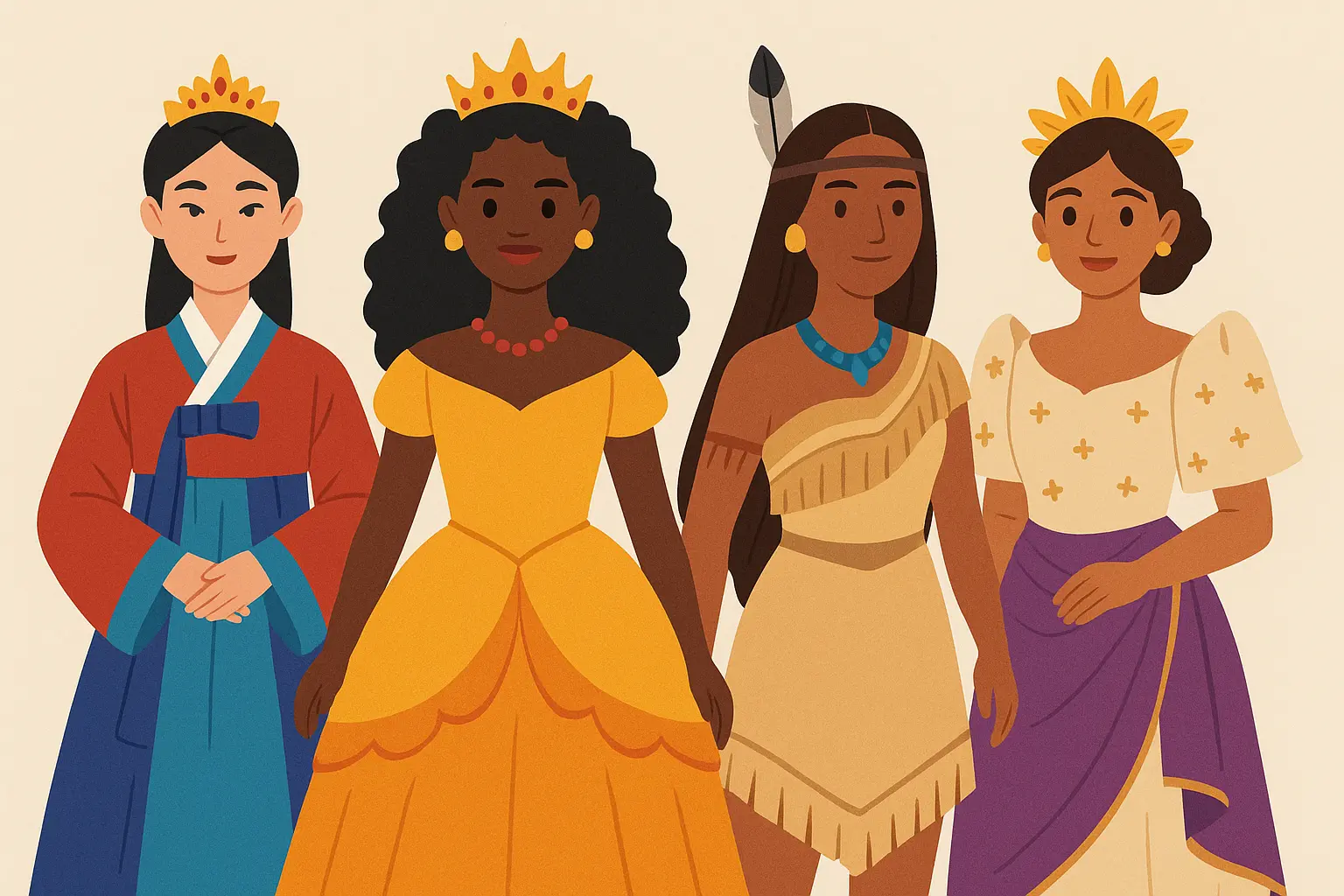
6. Mulan (Chinese)
The legendary tale of a young woman who disguises herself as a man to serve in the army in her father’s place. This story is all about honor, family loyalty, courage, and challenging what people expect from you while serving your community. Mulan doesn’t wait around for rescue – she creates her own solutions.
You can adapt this story depending on your kid’s age – the family loyalty angle works great for younger children, while older ones can grasp the bigger themes about war, sacrifice, and social expectations. Mulan’s intelligence and strategic thinking show that physical strength isn’t the only form of courage. Her ultimate revelation and acceptance by her fellow soldiers teaches kids about authenticity and being true to yourself while helping others. The emphasis on honor and duty provides strong moral foundations while challenging traditional gender roles.
Writers looking to explore similar themes of transformation and cultural identity can find inspiration in our collection of folktale story examples that showcase diverse storytelling traditions from around the world.
7. Princess Kaguya (Japanese)
A bamboo cutter discovers a tiny princess inside a bamboo stalk who grows into a beautiful woman courted by many suitors. This story explores belonging, the tension between earthly and celestial worlds, and the bittersweet nature of love and duty.
The contemplative, mystical storytelling creates a particularly soothing atmosphere for bedtime. Princess Kaguya’s connection to nature and celestial themes provides dreamy imagery that’s perfect for sleep preparation, while the story’s focus on honesty – as each suitor tries deception rather than genuine effort – teaches important moral lessons.
When Princess Kaguya reveals she’s actually from the Moon and must return to her celestial home, kids learn about the temporary nature of relationships and the importance of cherishing time together. The story’s gentle melancholy and acceptance of life’s changes can help children process their own experiences of loss or change.
8. Princess Anansi (West African)
Princess stories featuring clever characters from West African folklore who use wit and wisdom to solve problems and help their people. These tales emphasize intelligence, community responsibility, and the power of storytelling itself, often with call-and-response elements traditional to West African culture.
In “Princess Anansi and the Drought of Stories,” the kingdom faces a crisis where all stories have vanished, leaving people unable to solve problems or find hope. Princess Anansi must journey to the Sky God’s realm, using her wit to complete three impossible tasks through clever wordplay and lateral thinking. The interactive elements – where kids can participate by repeating key phrases or predicting Princess Anansi’s solutions – make these stories particularly engaging for bedtime while teaching problem-solving skills. The emphasis on community responsibility and using intelligence to help others provides strong moral foundations.
9. Princess Pocahontas (Native American)
The story of a Native American princess who serves as a bridge between two worlds, emphasizing understanding, peace-making, and environmental stewardship. Modern retellings focus on her diplomatic skills and connection to nature rather than romanticized historical inaccuracies.
Real talk: These stories require careful handling to respect Native American culture and avoid stereotypes, focusing instead on documented elements of diplomacy, environmental awareness, and cross-cultural understanding. Princess Pocahontas’s role as a mediator teaches kids about conflict resolution and seeing different perspectives. The emphasis on environmental stewardship and connection to nature provides calming bedtime imagery while teaching children about responsibility toward the natural world. Her diplomatic skills show that intelligence and communication solve conflicts more effectively than force.
10. The Papaya Princess (Filipino)
A tale about a princess who must choose between personal happiness and duty to her people during a time of great need. This story teaches about sacrifice, leadership, and the responsibilities that come with privilege while introducing children to Filipino cultural elements.
The story’s focus on community needs versus personal desires helps children understand complex moral decisions and the weight of responsibility. The princess’s ultimate choice to serve her people shows that true leadership sometimes requires personal sacrifice for the greater good. Filipino cultural elements – including respect for elders, community cooperation, and connection to nature – are woven throughout the narrative, providing cultural education while maintaining universal themes that resonate across backgrounds. The tropical setting and fruit imagery create vivid, appealing visuals for bedtime.
Perfect for Strong-Willed Kids (Stories 11-15)
11. Princess Smartypants
A clever princess who has zero interest in marriage and outsmarts all her suitors through impossible tasks. She ultimately chooses independence over traditional expectations, teaching kids about personal choice and self-determination while staying happy and fulfilled.
Princess Smartypants assigns each suitor increasingly ridiculous tasks – feeding her dangerous pets, retrieving rings from dragons, spending nights in haunted towers – with escalating humor that builds to a satisfying twist ending. When Prince Swashbuckle completes all tasks, she uses her secret witch powers to transform him into a toad rather than marry him.
This story directly challenges traditional princess narratives, making it excellent for kids who question conventional gender roles. The humor and clever plot twists keep children engaged while delivering empowering messages about the validity of choosing to remain single and prioritizing personal happiness over social expectations.
12. The Paper Bag Princess
Princess Elizabeth’s kingdom gets destroyed by a dragon who kidnaps her prince. She cleverly outwits the dragon using her intelligence rather than waiting for rescue, discovering that her prince isn’t worthy of her cleverness and strength when he criticizes her appearance after she saves him.
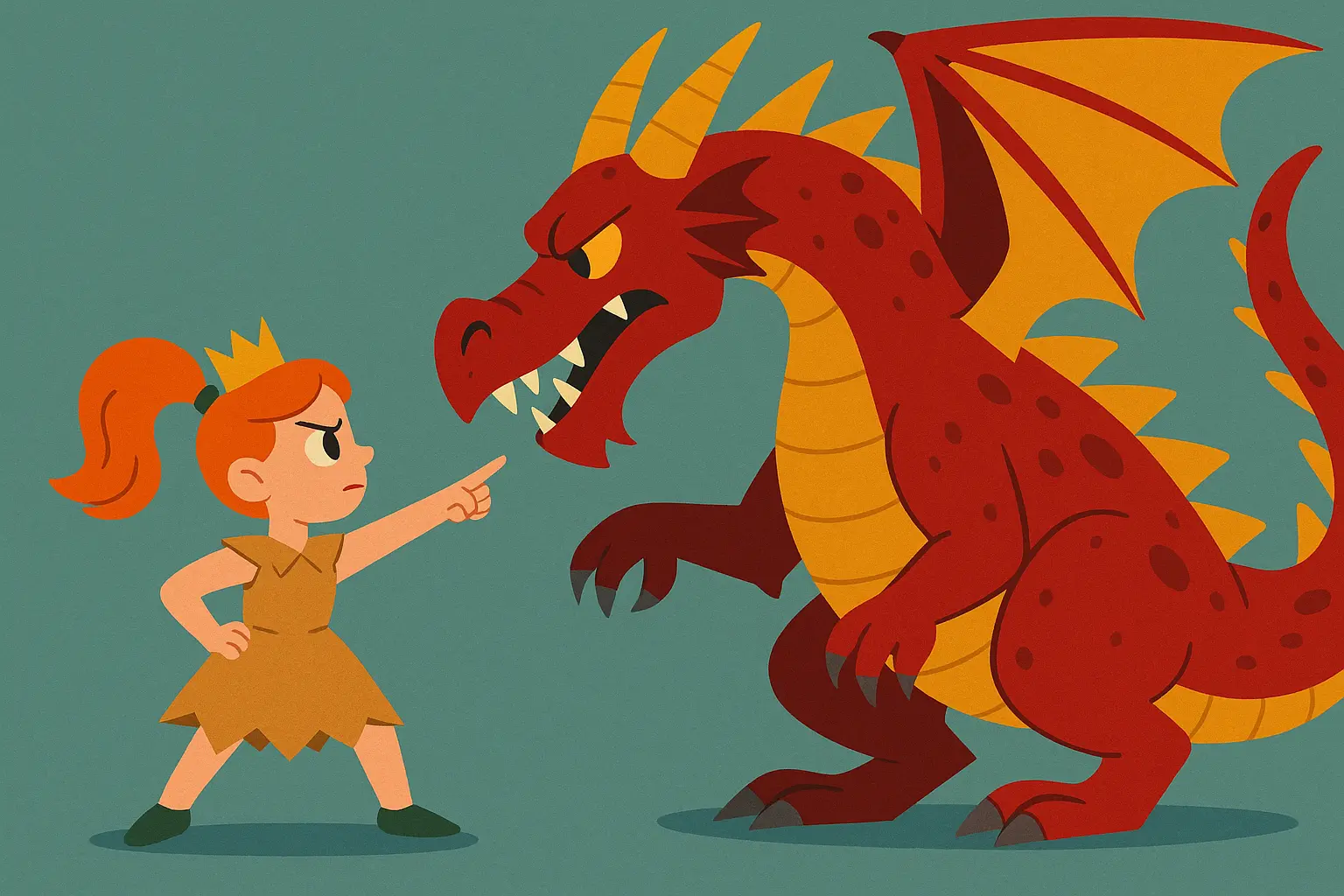
This story completely flips traditional rescue narratives on their head, emphasizing intellectual problem-solving over physical confrontation. Elizabeth uses psychology to exhaust the dragon, flattering it into showing off its abilities until it falls asleep from exhaustion, proving that brains beat brawn. When Prince Ronald criticizes her paper bag attire and suggests she return when she looks more appropriate, Elizabeth realizes he’s “a bum” and chooses to dance off into the sunset alone and happy.
Your kid will probably want to wear a paper bag after this one. Just go with it. Also, be prepared for some interesting conversations about what makes someone “worthy” of your attention. This powerful ending teaches children about self-worth and refusing to settle for relationships that don’t value their strengths.
Parents interested in exploring more empowering narrative structures can discover additional examples in our guide to story theme examples that showcase various approaches to character development and moral messaging.
13. Princess Penelope’s Perfectly Purple Day
A story about a princess who loves the color purple and insists on wearing it despite court expectations. She learns to balance personal preferences with social situations while maintaining her individuality and expressing her authentic self.
The story addresses the balance between individual expression and social expectations in a way kids can actually understand, helping them figure out when to compromise and when to stand firm on personal values. Princess Penelope’s journey shows that you can honor your preferences while being considerate of others. The focus on color preference provides a simple, relatable conflict that younger children can easily grasp while learning about self-expression, compromise, and staying true to personal identity. The resolution shows that authenticity and consideration for others can coexist.
14. The Princess Knight
A tale of a princess who wants to become a knight and fight dragons. She trains in secret and ultimately proves that courage and skill matter more than gender when protecting others, challenging traditional gender roles while maintaining adventure elements.
The training sequences and dragon-fighting elements add excitement while maintaining positive messages about determination and skill-building. The princess’s dedication to developing her abilities teaches children that achieving goals requires practice, persistence, and courage to challenge expectations. Her ultimate success in protecting others demonstrates that heroism comes in many forms and that traditional gender roles shouldn’t limit personal aspirations. This story appeals to kids interested in adventure while breaking stereotypes about what princesses can and should do.
15. Princess Ruby’s Perfectly Imperfect Day
A modern princess learns that perfection isn’t necessary for happiness or success. Through various mishaps and adventures, she discovers the joy in embracing mistakes and learning from them rather than striving for impossible standards.
Seven-year-old Marcus was a perfectionist who would have meltdowns when his drawings didn’t look exactly right. His father began reading “Princess Ruby’s Perfectly Imperfect Day” nightly, emphasizing how Ruby’s “mistakes” led to helping a lost kitten, discovering a new garden path, and making a friend. Marcus gradually began saying “That’s okay, I’m having a Princess Ruby day” when things didn’t go perfectly, learning to see mistakes as adventures rather than failures.
This story is particularly valuable for perfectionist children, teaching them that mistakes are learning opportunities and that authenticity is more valuable than perfection. Princess Ruby’s journey through a day filled with small disasters shows how resilience and humor can transform setbacks into growth experiences. Each mishap becomes a chance for Princess Ruby to help others or discover something new about herself, demonstrating that unexpected events often lead to the best outcomes.
When Your Child Needs Friend Drama Help (Stories 16-19)
16. The Princess and the Friendship Garden
A lonely princess creates a magical garden where she learns to make friends with children from the village. The story emphasizes that true friendship crosses social boundaries and that kindness creates lasting bonds between people from different backgrounds.
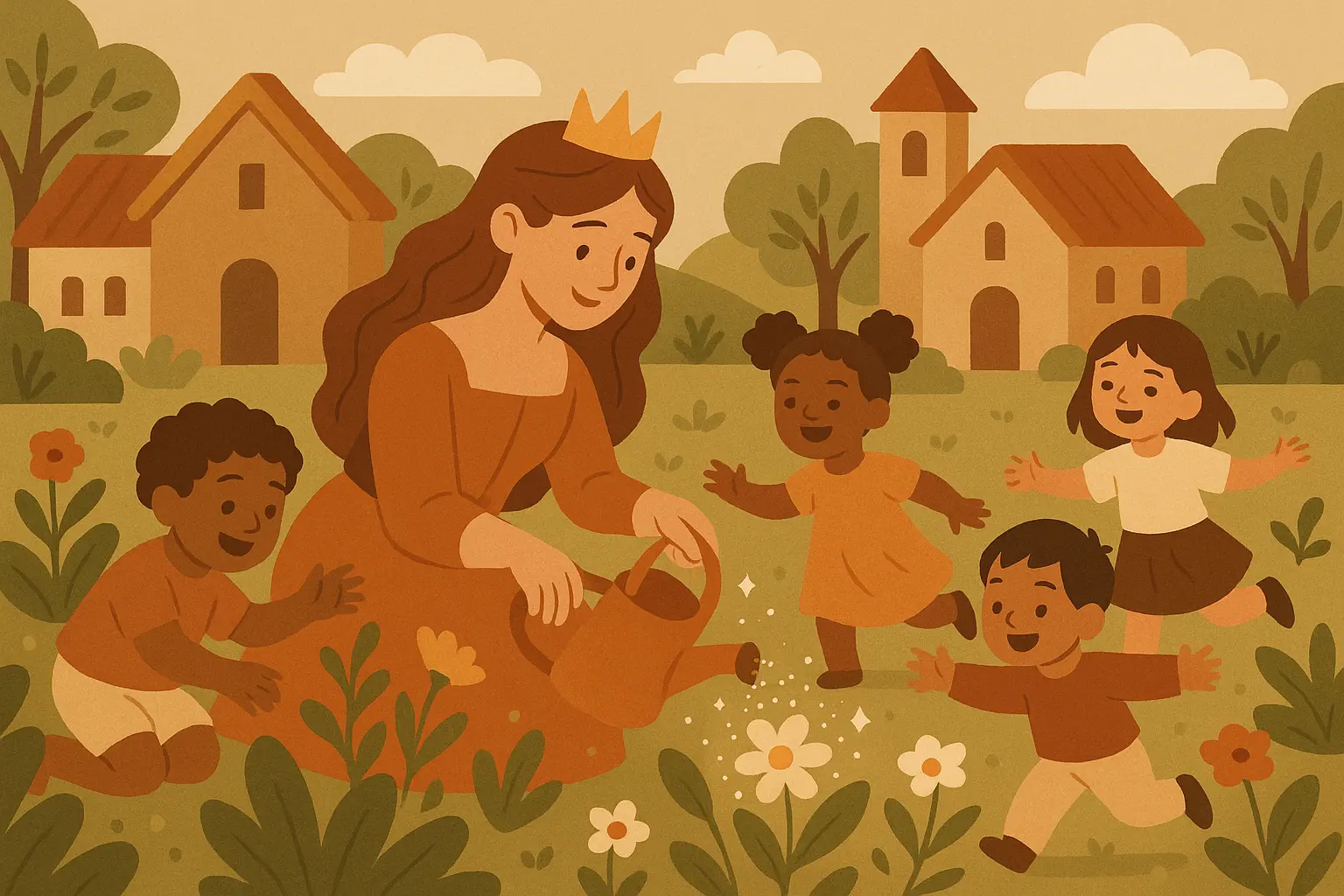
The garden serves as a concrete representation of how relationships grow with care, patience, and attention. Each plant in the garden represents a different friendship, teaching children that relationships require nurturing and that diversity makes communities stronger and more beautiful. The princess’s initial loneliness resonates with kids who struggle to make friends, while her proactive approach to creating opportunities for connection provides a practical model. The magical elements make the story engaging while the friendship lessons remain grounded and applicable to real life.
17. Princess Stella’s Starlight Academy
A princess who starts a school for all children in her kingdom, regardless of their background. She learns about different perspectives and the importance of education and inclusion in building strong communities while discovering that teaching and learning go both ways.
This story promotes educational values while teaching about inclusion and the importance of diverse perspectives in learning environments. Princess Stella discovers that she learns as much from her students as they learn from her, demonstrating that everyone has valuable knowledge to share. The academy setting allows for exploration of different subjects, learning styles, and cultural backgrounds, making it particularly appealing to school-age children. The emphasis on education as a tool for building stronger communities provides positive messages about learning and cooperation.
If you’ve got multiple kids, this one works great because it’s about including everyone. The message about different perspectives making learning richer really resonates with kids dealing with classroom dynamics.
18. The Princess and the Dragon’s Tea Party
A princess befriends a misunderstood dragon and teaches her kingdom that differences should be celebrated, not feared. Together they host tea parties that bring the community together and promote understanding between different groups.
This story transforms the traditional princess-dragon conflict into a friendship narrative, teaching children about overcoming prejudice and finding common ground with those who seem different. The tea party setting provides a peaceful, civilized context for building relationships and understanding. The dragon’s initial loneliness and the princess’s willingness to look beyond appearances demonstrate that friendship can develop in unexpected places. The community’s gradual acceptance shows how individual relationships can change broader social attitudes and reduce fear of differences.
19. Princess Maya’s Musical Kingdom
A princess who uses music to unite her diverse kingdom and solve conflicts peacefully. She learns that harmony in music reflects harmony in relationships and community building, discovering that different voices create richer, more beautiful compositions.
This story appeals particularly to musically inclined children while teaching universal lessons about cooperation and conflict resolution. Princess Maya’s discovery that different instruments and voices create richer music provides a concrete understanding of how diversity strengthens communities. Musical elements throughout the story create opportunities for interactive reading, with parents and children creating sounds or singing together. The peaceful conflict resolution through music demonstrates alternatives to fighting and shows how creativity can solve problems.
For the Little Problem Solvers (Stories 20-22)
20. The Princess Detective
Princess Sophia runs the Royal Detective Agency from her castle tower, using scientific methods and logical deduction to solve mysteries throughout her kingdom. Her stories teach critical thinking skills and the satisfaction of using intelligence to help others while maintaining magical castle settings.
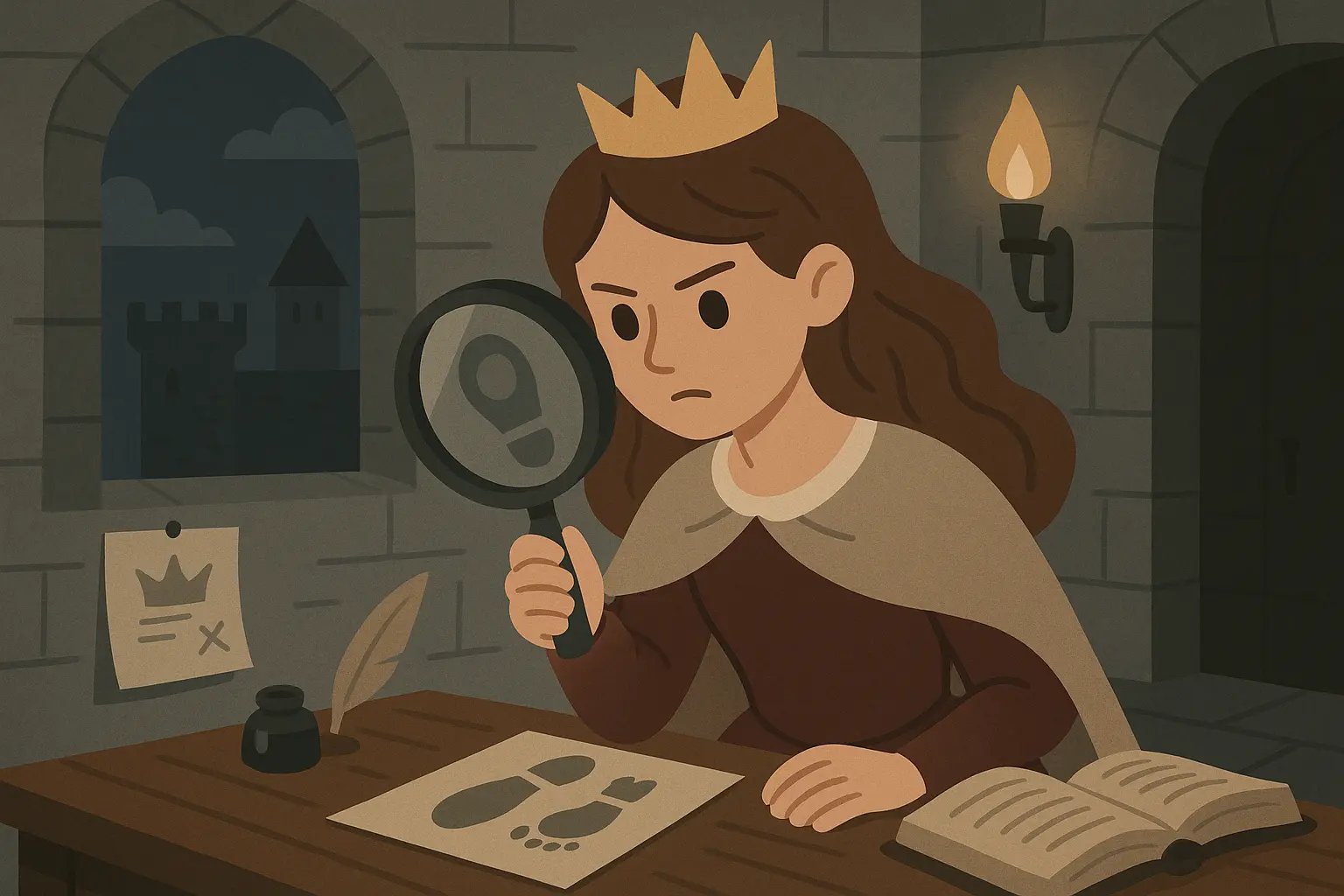
Each mystery follows a clear structure: crime discovery, evidence gathering, witness interviews, hypothesis formation, testing, and logical solution revelation. Princess Sophia’s toolkit includes magnifying glasses, evidence bags, notebooks, and chemistry sets, introducing children to scientific investigation methods. These stories work well for bedtime because mystery resolution provides satisfying closure, and children can mentally review clues and solutions as they fall asleep. The emphasis on observation skills, logical thinking, and helping others through intelligence provides positive role modeling for problem-solving approaches.
Heads up: The detective princess stories might lead to your kid trying to “solve mysteries” around the house. Hide anything you don’t want investigated.
For parents seeking to develop their children’s creative problem-solving abilities, our guide on how to write a story using brain science offers insights into crafting narratives that enhance cognitive development and critical thinking skills.
21. Princess Explorer’s Magical Map
A curious princess discovers a magical map leading to adventures that teach her about different lands, cultures, and ways of life. Each journey brings new challenges requiring creativity and adaptability while satisfying children’s love of adventure and discovery.
The story structure builds excitement early but resolves peacefully, making it suitable for bedtime while satisfying adventure-loving children. Each destination introduces different cultures and problem-solving approaches, promoting curiosity and adaptability while broadening worldviews. Princess Explorer’s willingness to embrace new experiences and learn from different cultures provides positive modeling for children who might be hesitant about new situations. The magical map element maintains fantasy appeal while the cultural learning provides educational value.
22. The Inventor Princess
Princess Gadget lives in a workshop-castle where she creates inventions to solve problems for her people. Her stories follow the engineering process from problem identification through testing, failure, redesign, and ultimate success, encouraging STEM thinking while maintaining fantasy elements.
Each invention incorporates both scientific principles and magical elements – her cloud-catching machine uses engineering but is powered by crystals that respond to good intentions. This blend maintains fantasy appeal while teaching real scientific concepts and problem-solving approaches. The stories show that failure is part of the invention process, teaching persistence and resilience while demonstrating how creativity and technical skills can help others.
Fair warning: The inventor princess stories might inspire your kid to try “inventing” things with your kitchen utensils. Hide the good stuff.
When Bedtime Gets Emotional (Stories 23-25)
23. Princess Luna’s Feelings Crown
A story about a princess who learns to understand and manage her emotions through a magical crown that changes colors based on her feelings. She teaches others in her kingdom about emotional awareness and empathy while providing concrete tools for discussing emotions.
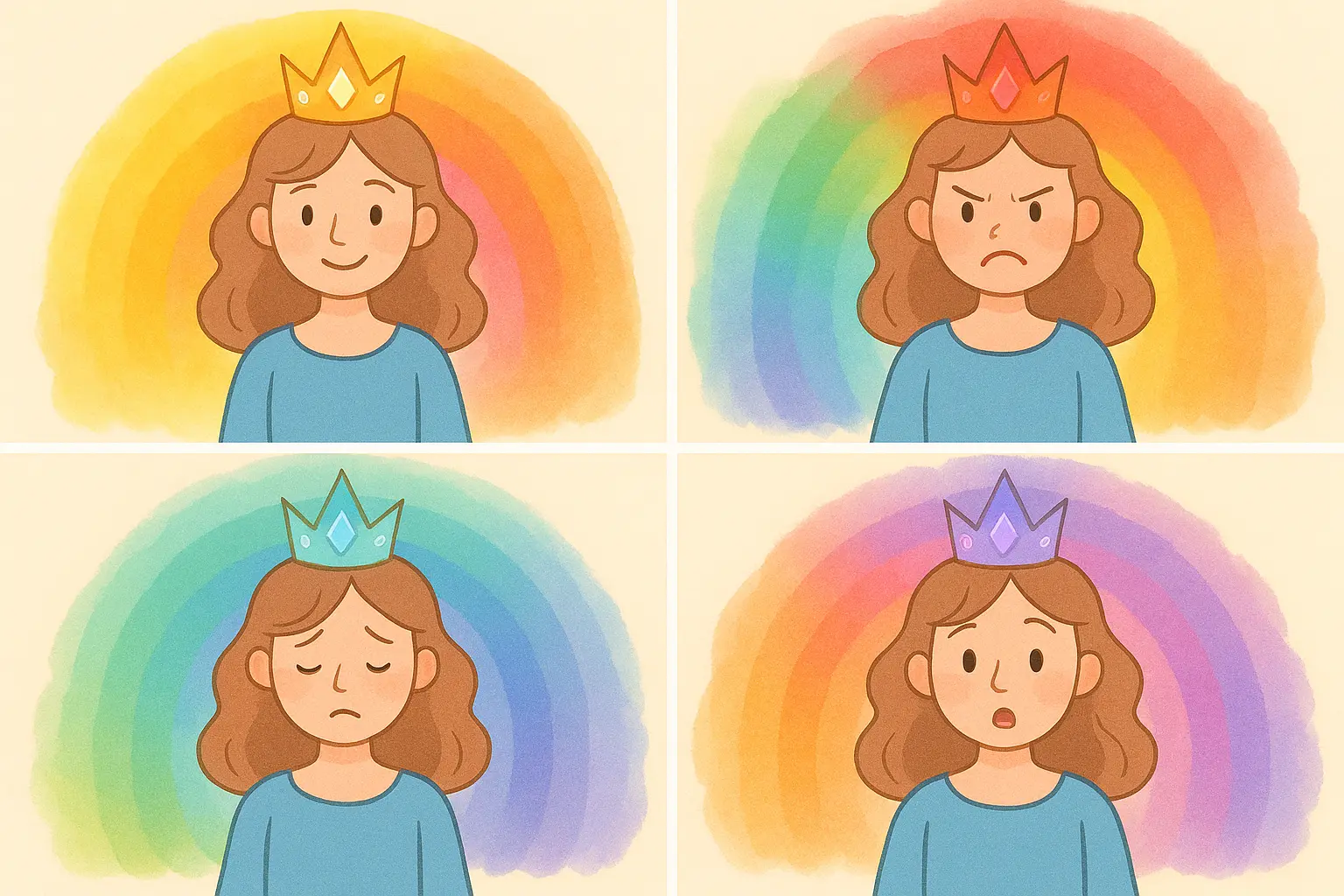
The crown provides a visual, concrete tool for discussing emotions, making it particularly valuable for children who struggle with emotional awareness or expression. Different colors represent different feelings, giving children vocabulary and visual cues for identifying and communicating their emotional states. Princess Luna’s journey from emotional confusion to emotional mastery provides a clear progression that children can follow and apply to their own lives. The story includes practical strategies for managing difficult emotions while validating all feelings as normal and important.
Yes, you’ll probably end up talking about feelings crowns for weeks after reading this. It’s actually pretty helpful for getting kids to open up about their emotions.
24. The Shy Princess Finds Her Voice
A tale of a quiet princess who discovers that her gentle nature and careful listening are valuable leadership qualities. She learns to speak up when it matters while appreciating her naturally thoughtful personality and finding confidence in her authentic self.
Ten-year-old Sarah was extremely shy and worried she wasn’t as valuable as her outgoing classmates. Her teacher recommended “The Shy Princess Finds Her Voice” for family reading time. As Sarah’s parents read about how the princess’s quiet observations helped solve kingdom problems, Sarah began recognizing her own strengths. She started contributing thoughtful insights during class discussions and eventually became the class mediator, using her listening skills to help resolve conflicts between friends.
This story validates introverted children while teaching them that quiet strengths are valuable and that they can still be leaders in their own way. The princess’s journey shows that leadership comes in many forms and that thoughtful observation and careful listening are powerful leadership tools. Her gradual confidence building provides a realistic model for shy children, showing that you don’t need to become extroverted to find your voice.
25. Princess Courage’s Big Small Steps
A princess who feels afraid of many things learns that courage isn’t the absence of fear, but taking small steps despite being scared. Each small act of bravery builds her confidence and helps others find their own courage while providing practical approaches to overcoming anxiety.
This story is excellent for anxious children, teaching practical approaches to overcoming fear and building confidence gradually. Princess Courage’s journey shows that bravery comes in small increments and that each small step makes the next one easier to take. Her discovery that helping others find courage actually increases her own confidence demonstrates the reciprocal nature of bravery and community support. The story provides concrete examples of small brave acts that children can apply to their own fears and challenges.
These princess bedtime stories offer children practical tools for emotional growth while maintaining the magical elements that make bedtime reading special.
How Each Story Meets Essential Selection Criteria
Understanding how these 25 princess stories align with your selection criteria helps you choose the perfect tale for any given night or child’s specific needs. Each story has been evaluated across multiple dimensions to ensure it delivers both entertainment value and developmental benefits.
|
Story Category |
Age Range |
Primary Educational Focus |
Cultural Elements |
Bedtime Suitability |
|---|---|---|---|---|
|
Classic Fairy Tales |
3-8 years |
Moral lessons, kindness |
European traditions |
High – peaceful endings |
|
Culturally Diverse |
5-12 years |
Cultural awareness, diversity |
Global traditions |
Medium-High – varied pacing |
|
Modern Independent |
6-12 years |
Self-determination, agency |
Contemporary values |
High – empowering conclusions |
|
Friendship/Community |
4-10 years |
Social skills, cooperation |
Universal themes |
High – relationship focus |
|
Problem-Solving |
7-12 years |
Critical thinking, STEM |
Modern applications |
Medium – exciting but resolved |
|
Emotional Intelligence |
4-12 years |
Self-awareness, empathy |
Psychological development |
Very High – calming themes |
Look, some nights you’ll nail the perfect story choice and your kid will drift off peacefully. Other nights they’ll be wide awake asking detailed questions about dragon biology. Both are normal.
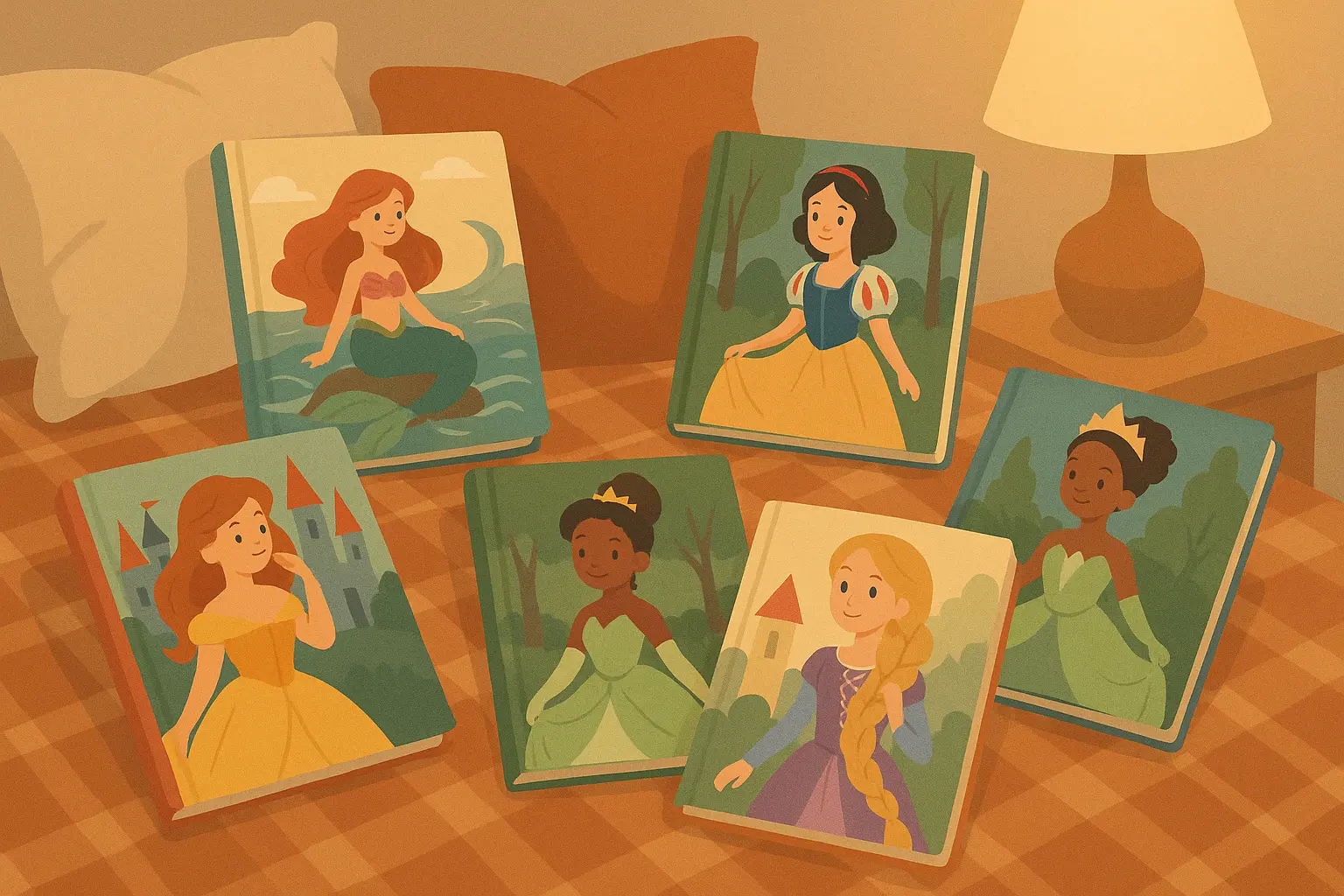
Age appropriateness varies significantly across the collection. Classic fairy tales work perfectly for ages 3-5 with their simple language and clear moral lessons. Modern stories and friendship tales suit ages 6-8 with more complex narratives that remain accessible. Adventure stories and culturally diverse tales offer sophisticated themes perfect for ages 9-12.
Educational value remains consistent throughout the collection, with each story integrating important life lessons without being preachy about it. Character development appears in every tale through positive trait modeling including kindness, courage, and perseverance. Problem-solving skills get specific attention in detective and inventor princess stories that teach logical thinking. Emotional intelligence receives explicit focus in several stories about understanding and managing feelings. Cultural awareness develops through diverse princess stories that introduce different traditions and perspectives.
Cultural representation spans geographic and social diversity intentionally. The collection includes stories from Asian, African, Native American, European, and Filipino traditions, ensuring broad cultural exposure. Social diversity appears through princesses from different economic backgrounds and circumstances. Personality diversity showcases introverted and extroverted princesses, creative and analytical types, traditional and non-conformist characters.
Pro tip: Keep 2-3 backup stories ready for when your kid suddenly decides their favorite is “too scary” or when you need something shorter because bedtime got pushed back.
Creating Personalized Princess Adventures with AI
Finding the perfect princess bedtime story gets challenging when your child has super specific interests that don’t quite match existing tales. Maybe they love detective work but want their princess to be from their own cultural background. Perhaps they’re fascinated by inventions but need stories that address their particular fears or challenges.
|
Story Element |
Traditional Approach |
AI-Personalized Approach |
Benefits |
|---|---|---|---|
|
Character Background |
Limited cultural options |
Any cultural combination |
Authentic representation |
|
Personality Traits |
Fixed character types |
Customizable traits mix |
Matches child’s interests |
|
Problem-Solving Style |
Predetermined methods |
Adaptable to child’s strengths |
Builds confidence |
|
Setting |
Standard fairy tale locations |
Familiar environments |
Increases relatability |
|
Educational Focus |
General life lessons |
Targeted skill development |
Addresses specific needs |
|
Language Complexity |
Fixed vocabulary level |
Adjustable difficulty |
Perfect comprehension level |
This is where AI-powered story generation actually becomes useful – they can mash together whatever weird combination your kid dreams up. When you want to combine elements from multiple princess archetypes – creating a shy inventor princess who must solve mysteries in her culturally diverse kingdom – AI can seamlessly blend these elements into coherent, engaging narratives.
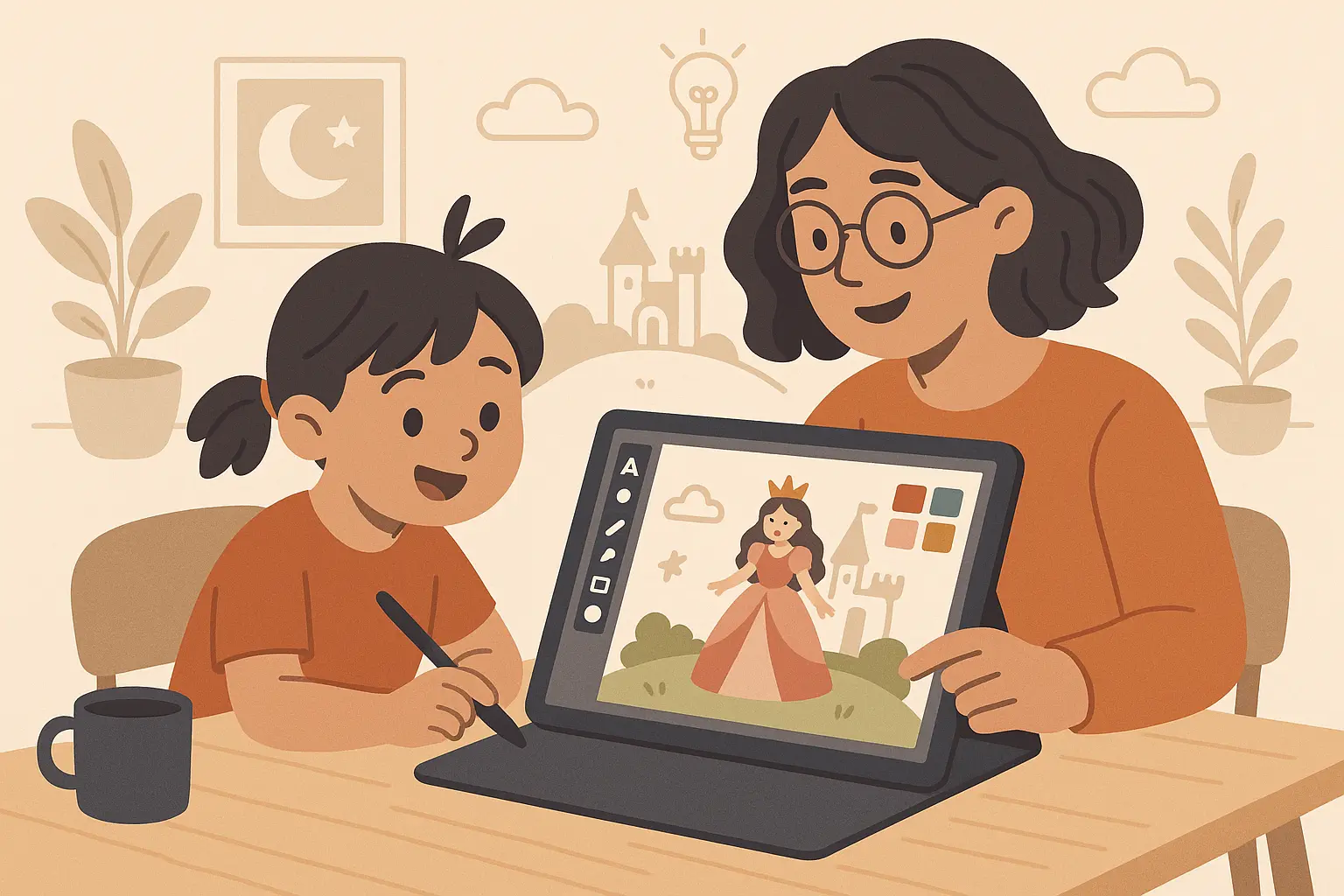
Nairrate’s story generation capabilities excel at understanding narrative structure and character development, making it particularly valuable for parents who want custom princess stories addressing their child’s specific emotional needs. The platform can adjust language complexity for different ages, incorporate specific educational goals, and maintain appropriate pacing for bedtime while honoring your child’s interests and cultural background.
Parents can explore Nairrate’s bedtime story generator to create personalized princess adventures that combine traditional fairy tale elements with their child’s specific interests and developmental needs.
Whether you need a story combining your child’s love of music with their interest in different cultures, or you want help crafting an opening that immediately captures their imagination while setting up a peaceful bedtime narrative, Nairrate’s collaborative approach transforms bedtime routines into opportunities for creative co-creation between parent, child, and AI.
The platform’s ability to generate culturally authentic stories that reflect your family’s heritage while incorporating modern values of independence and problem-solving addresses the gap many parents feel between generic princess stories and tales that truly resonate with their child’s identity and experiences.
For additional creative inspiration, parents can also utilize Nairrate’s kids story generator to develop age-appropriate narratives that blend educational content with entertaining princess adventures tailored to their child’s unique personality and interests.
Ready to create magical, personalized princess bedtime stories that perfectly match your child’s interests and developmental needs? Explore Nairrate’s story generation tools and discover how AI can help you craft unforgettable bedtime adventures that combine traditional princess magic with modern storytelling innovation tailored specifically for your unique child.
Final Thoughts
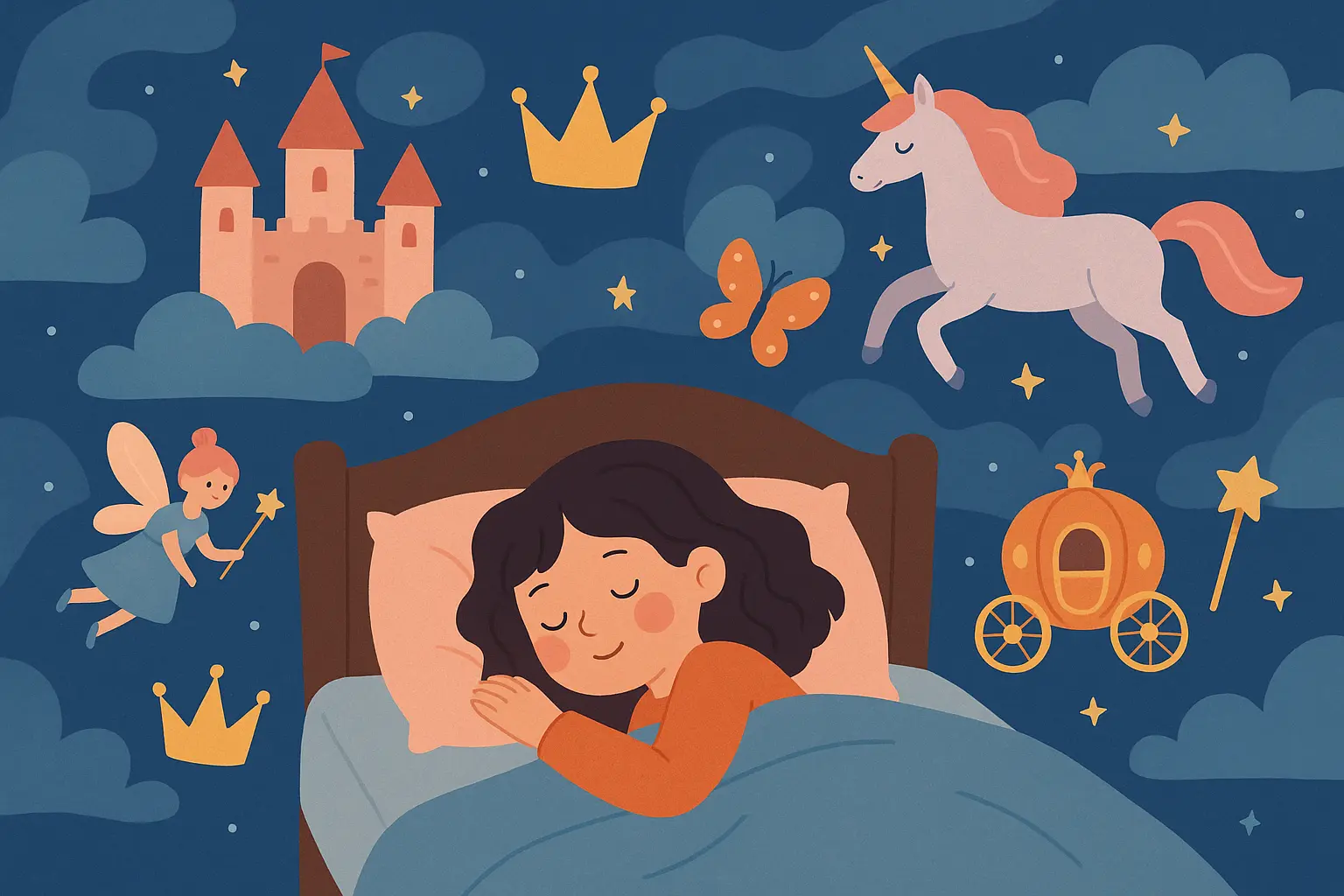
Here’s the thing – you don’t need to be perfect at this. Princess bedtime stories offer way more than simple entertainment. They’re powerful tools for teaching life lessons, building emotional intelligence, and creating peaceful transitions to sleep. The 25 stories covered in this guide represent a carefully curated collection that balances traditional fairy tale magic with contemporary values, ensuring your child gets both the comfort of familiar storytelling patterns and the empowerment of modern princess narratives.
Some nights you’ll pick the wrong story and your kid will be bouncing off the walls. Some nights you’ll nail it and they’ll ask for the same story for three weeks straight (yes, you’ll get sick of it). Both scenarios are totally normal.
The key to successful princess bedtime stories lies in matching the right tale to your child’s current developmental needs, interests, and emotional state. Some nights call for the gentle humor of “The Princess and the Pea,” while others might need the empowering message of “The Paper Bag Princess” or the cultural richness of “Princess Kaguya.” Having a diverse collection ensures you’re prepared for whatever your child needs to end their day peacefully.
Quick Reference Guide
Too tired to read this whole thing? Here’s the cheat sheet:
-
Cranky kid: Classic fairy tales (comfort food for the soul)
-
Defiant kid: Modern independent princesses
-
Scared kid: Friendship stories
-
Curious kid: Problem-solving adventures
-
Emotional kid: Feelings-focused stories
-
Any kid, any night: Pick one and roll with it
Some practical tips: If your kid gets wound up during exciting parts, try reading in a slower, quieter voice as you approach bedtime. Some nights you’ll need to skip the dragon parts – trust your gut on what your kid can handle. Keep a few favorites bookmarked for those nights when you’re too tired to think.
Remember that these stories work best when they become part of a consistent, calming bedtime routine that signals to your child that it’s time to relax and prepare for sleep. The magic happens in those quiet moments of connection they create between you and your child, building memories that will last long after they’ve outgrown bedtime stories.
The goal isn’t to become a bedtime story expert. It’s to spend a few minutes connecting with your kid before they sleep, maybe teach them something cool, and hopefully get them calm enough that you can finally collapse on the couch with whatever’s left of your sanity.
These 25 stories give you options for whatever mood your kid is in. Don’t stress about finding the “perfect” story every time. Your kid just wants you there, reading to them. Everything else is bonus.
Yes, you’ll probably memorize these stories. Yes, you’ll catch yourself reciting Princess Luna’s feelings crown colors while grocery shopping. This is normal. And honestly? These moments of shared imagination and learning are what childhood memories are made of.



Add comment